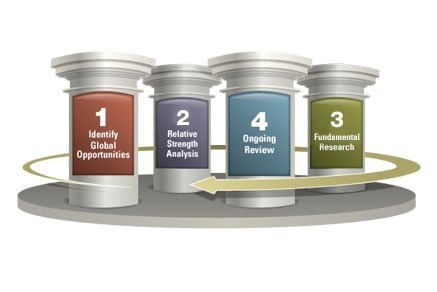Relative Strength Momentum Investing Invest Safely Tips
Post on: 26 Апрель, 2016 No Comment

Relative Strength Momentum (RSM) is a statistic that measures the acceleration of the relative strength (stock, mutual fund or ETF). This makes RSM a key to safe investing. The higher the Fast Moving Average moves above the Slow Moving Average the greater the ranking value.
Relative Strength Momentum investing is a proven, successful way to analyze and select stocks, mutual funds, and ETFs. There are a few simple mistakes or common fallacies that can endanger this type of analysis. Perhaps the best way to truly understand Relative Strength Momentum (RSM) investing is to compare it to simple momentum investing.
Almost all investors base their decisions on some type of momentum-some kind of indication that a ticker symbol is or soon will be going up. The challenge, even with a variety of charts, is trying to determine to what degree the stock will rise. Analysis based on RSM takes simple momentum analysis a step further by performing a comparative analysis of how strong the momentum of the stock, ETF or mutual fund is and if the analysis is properly setup, and it can determine how strong the particular symbol is in comparison with another symbol. This compelling RSM analysis focuses on symbols that are strong and have the potential not only to maintain their strength, but to continue rising; and, if, or when they do falter, the RSM analysis signals you that it’s time to sell.
As with any conservative or moderate investment strategy, the challenge is in defining the parameters, the rules of analysis; in other words, what settings do you use with relative strength momentum to ensure safe investing?
While the analysis settings may appear to be similar to those of a Moving Average (MA), the formulas are different. For an MA, the formula involves using both the fast and slow moving averages (MA) of the symbol or even of the group of symbols. There are also basic RSM formulas and variations such as “alpha”.
A typical setting might be a fast MA of 20 and a slow MA of 60. In fact I frequently use this particular setting for my Moving Average (MA) chart, but in relative strength momentum, the math is more advanced.
Tip: if math isn’t your forte, a good personal investment software program that offers RSM and Alpha will do all the math for you, so you don’t need to be a math genius or an Excel genius to get safe investment recommendations.
As in all things, there are some pitfalls with RSM that you will need to avoid:
First: there are different RSM formulas such as basic RSM and Alpha, or RSM with Standard Deviation. You need to recognize that the different types of analysis are not necessarily all suited for all types of investments.
Yes, basic RSM will work with stocks, ETFS, and mutual funds, but it performs best with stocks that issue dividends. In other words, it is best if you back test different types of RSM and discover for yourself the appropriate method to achieve the best returns with the least amount of risk and to limit losses.
Second: the same parameters or settings for analysis do not work for all stocks, or for all groups of stocks, ETFs, or mutual funds. Understanding this fundamental principle is critical . Just because a setting of fast 20 and slow 60 may work with one group of stocks doesn’t necessarily mean it will provide the best results with another. Again, back testing using different settings is absolutely essential, and using an investment software program that can automatically optimize and test different settings to find the optimum setting for you is preferable.
Third: stick with your back tested and proven settings. Yes, you may want to optimize and verify your settings every year or so, but more frequent changes to your strategies reduce the dependability for long-range or even short-range success. Instead of relying on the math or on the analysis, you are really letting emotion take over when you change the settings every time the market hiccups.
Personally, I have found that the same settings never work for all groups of mutual funds, ETFs, or stocks; all of them are unique. I also rarely re-optimize or back test to find new settings; once very few years has proven more than sufficient for my moderate investment strategy, and this can be your key to successful investing.
Raymond M.F. Dominick is the author of “Invest Safely and Profitably” (Your Success Guide), available from Amazon .














